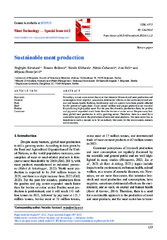Приказ основних података о документу
Sustainable meat production
| dc.creator | Karabasil, Nedjeljko | |
| dc.creator | Bošković, Tamara | |
| dc.creator | Kilibarda, Nataša | |
| dc.creator | Čobanović, Nikola | |
| dc.creator | Vićić, Ivan | |
| dc.creator | Dimitrijević, Mirjana | |
| dc.date.accessioned | 2023-11-08T07:39:14Z | |
| dc.date.available | 2023-11-08T07:39:14Z | |
| dc.date.issued | 2023 | |
| dc.identifier.issn | 2466-4812 | |
| dc.identifier.uri | https://vet-erinar.vet.bg.ac.rs/handle/123456789/3322 | |
| dc.description.abstract | Nowadays, we are more aware than ever that intensive livestock and meat production and consumption have negative, sometimes detrimental effects on the environment and ani‑ mal and human health. Habitats, biodiversity and soil quality have been greatly affected by the growth of agriculture. Good animal welfare and proper protection are essential for producing high‑quality meat. For the past few decades, production from the poultry and pig sector expanded much faster than the bovine or ovine sector. Despite many bar‑ riers, global meat production is still a growing sector. Therefore, there is a need for a sustainable approach to the production of meat and meat products. The meat sector has to transform in such a manner as to be an industry that cares for the environment, animals and consumers. | sr |
| dc.language.iso | en | sr |
| dc.publisher | Institute of Meat Hygiene and Technology | sr |
| dc.relation | info:eu-repo/grantAgreement/MESTD/inst-2020/200143/RS// | sr |
| dc.rights | openAccess | sr |
| dc.rights.uri | https://creativecommons.org/licenses/by/4.0/ | |
| dc.source | Meat Technology | sr |
| dc.subject | Iivestock | sr |
| dc.subject | Pork | sr |
| dc.subject | Beef | sr |
| dc.subject | Poultry | sr |
| dc.subject | Consumer | sr |
| dc.title | Sustainable meat production | sr |
| dc.type | article | sr |
| dc.rights.license | BY | sr |
| dc.citation.volume | 64 | |
| dc.citation.issue | 2 | |
| dc.citation.spage | 133 | |
| dc.citation.epage | 135 | |
| dc.identifier.doi | 10.18485/meattech.2023.64.2.23 | |
| dc.identifier.fulltext | http://veterinar.vet.bg.ac.rs/bitstream/id/9878/bitstream_9878.pdf | |
| dc.type.version | publishedVersion | sr |

